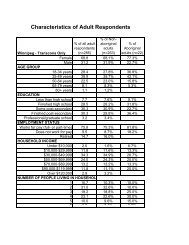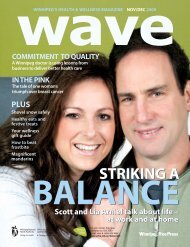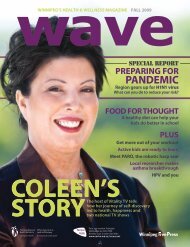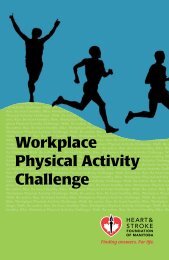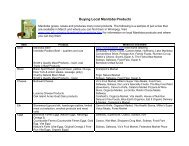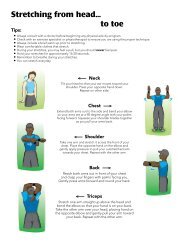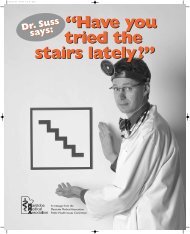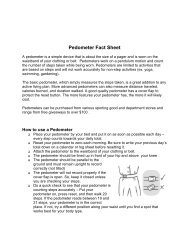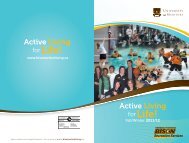Wave: March / April 2010 - Winnipeg in motion
Wave: March / April 2010 - Winnipeg in motion
Wave: March / April 2010 - Winnipeg in motion
You also want an ePaper? Increase the reach of your titles
YUMPU automatically turns print PDFs into web optimized ePapers that Google loves.
21. After a few years work<strong>in</strong>g at m<strong>in</strong>imumwage<br />
jobs, he was deeply immersed <strong>in</strong> theatre<br />
studies at the University of <strong>W<strong>in</strong>nipeg</strong>.<br />
“Suddenly, I began to have severe headaches,”<br />
says Jeff. “I didn’t sleep for a month.<br />
My family was helpless.” It was eventually<br />
determ<strong>in</strong>ed that Jeff had an aneurysm <strong>in</strong><br />
his bra<strong>in</strong> and had to undergo surgery to<br />
remove it.<br />
N<strong>in</strong>e years later, at age 30, Jeff was diagnosed<br />
with testicular cancer. He underwent<br />
surgery and radiation for seven weeks, and<br />
the cancer disappeared.<br />
Another decade, another crisis. In 1997,<br />
at 42, Jeff had the first of several operations<br />
to repair multiple aneurysms <strong>in</strong> his left leg.<br />
He has an arteriovenous malformation, a<br />
condition described as an abnormal connection<br />
between the arteries and ve<strong>in</strong>s. It’s<br />
a lifelong condition, which means Jeff will<br />
face more procedures as he ages.<br />
Despite everyth<strong>in</strong>g, Jeff is able to put a<br />
positive sp<strong>in</strong> on these experiences: “There<br />
is an upside to all this. Every time you go<br />
through a medical crisis, you learn more<br />
about yourself.”<br />
Still, noth<strong>in</strong>g prepared Jeff for chronic<br />
kidney disease. “Everyth<strong>in</strong>g else I had<br />
could be fixed. This can’t.”<br />
Not that he didn’t try.<br />
The journey beg<strong>in</strong>s<br />
Chronic kidney disease can be a very<br />
slow-develop<strong>in</strong>g condition. At the time of<br />
his diagnosis, Jeff was not required to do<br />
anyth<strong>in</strong>g. But his doctor told him what to<br />
expect: over time, his kidneys would start<br />
to fail and he would eventually need dialysis<br />
and a kidney transplant.<br />
Doctors couldn’t tell Jeff precisely when<br />
all this would happen as even a family history<br />
of polycystic kidneys was absent. This<br />
condition which is very often transmitted<br />
genetically, can have a relative predictive<br />
pattern of disease progression. Without a<br />
reference po<strong>in</strong>t, Jeff was enter<strong>in</strong>g unfamiliar<br />
medical terra<strong>in</strong>.<br />
Nonetheless, and despite past medical<br />
problems, Jeff believed he was basically<br />
pretty healthy. He was a non-smoker, rarely<br />
drank, and was careful to take vitam<strong>in</strong>s<br />
daily. In short, he hoped his generally<br />
healthy lifestyle would slow down the deterioration<br />
of his kidneys, maybe even halt it<br />
altogether.<br />
Once the diagnosis was <strong>in</strong>, Jeff started<br />
attend<strong>in</strong>g the renal cl<strong>in</strong>ic at Health Sciences<br />
Centre where his condition could be<br />
monitored. As expected, the disease ga<strong>in</strong>ed<br />
ground as the years went by. But even as<br />
Signs of kidney disease<br />
Kidney disease can sneak up on<br />
you, particularly <strong>in</strong> the very early stages,<br />
because there are no noticeable symptoms<br />
associated with the condition. It is<br />
important for high-risk <strong>in</strong>dividuals to be<br />
tested regularly to reduce the progression<br />
of kidney disease and ultimately<br />
reduce the need for dialysis. Kidney<br />
disease can affect anyone at any time,<br />
but some people may be more at risk<br />
than others.<br />
Risk factors for kidney disease:<br />
• Diabetes<br />
• High blood pressure<br />
• Ur<strong>in</strong>ary tract disorders<br />
• Autoimmune disease<br />
• Family history of kidney disease<br />
• Cardiovascular disease such as<br />
heart disease, strokes or peripheral<br />
vascular disease (poor leg circulation)<br />
• Excessive use of known tox<strong>in</strong>s (such<br />
as pa<strong>in</strong> killers and others)<br />
Eventually, people with kidney<br />
disease may notice:<br />
• Foam<strong>in</strong>g, bloody (resembl<strong>in</strong>g cocacola<br />
or tea) or cloudy ur<strong>in</strong>e<br />
• Edema (swell<strong>in</strong>g)<br />
• Trouble ur<strong>in</strong>at<strong>in</strong>g at night<br />
Later signs of kidney disease <strong>in</strong>clude:<br />
• Nausea and vomit<strong>in</strong>g<br />
• Persistent, ongo<strong>in</strong>g itch<strong>in</strong>g<br />
• Bone or jo<strong>in</strong>t pa<strong>in</strong><br />
• Decreased ur<strong>in</strong>e output (less than<br />
two cups per day)<br />
• Shortness of breath<br />
18 WAVE




